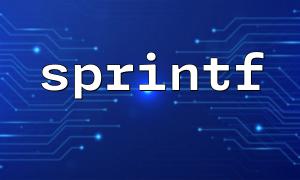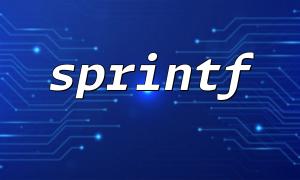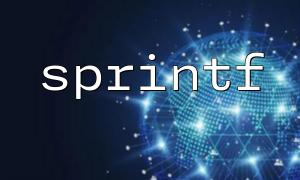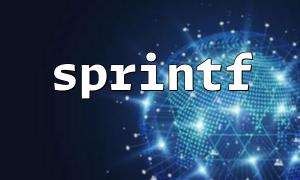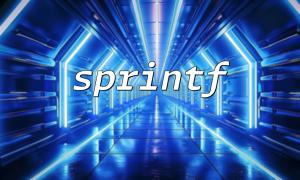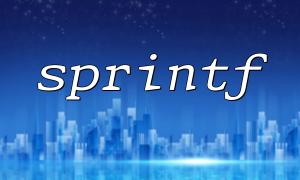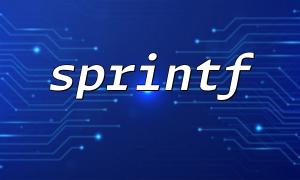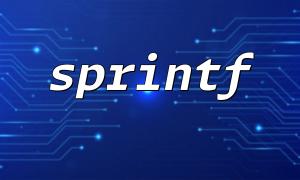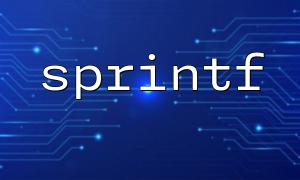In PHP, sprintf() is a very practical function that is used to output formatted strings to a variable or directly to the screen. When you run a PHP script in a command line (CLI) environment, sometimes we want to be able to add colors to the output to facilitate highlighting certain information.
In the CLI environment, color formatting is usually achieved through ANSI escape sequences. The sprintf() function can help us construct formatted strings with these ANSI escape codes to display colored text in the terminal.
This article will introduce how to use the sprintf() function to implement color formatting of command line output to ensure that your CLI output is more readable.
On the command line, colors are implemented through ANSI escape sequences. An ANSI escape sequence consists of a specific string of characters, usually starting with \033[ , followed by a series of numbers (representing color or style), and ending with the letter m . For example:
\033[31m is used to set red text
\033[32m is used to set green text
\033[0m is used to reset text color (restore default color)
Here are some common ANSI escape sequences:
\033[30m to \033[37m : Set different foreground colors (black, red, green, yellow, etc.)
\033[40m to \033[47m : Set different background colors (black, red, green, yellow, etc.)
\033[0m : Reset color
In PHP, when using these escape sequences to color text, we usually embed them into strings.
PHP 's sprintf() function can generate a variable for formatted strings. Using this feature, we can easily output text with color on the command line. We will use sprintf() to construct strings with color escape sequences.
For example, the following code example shows how to use sprintf() to implement colored command line output:
<?php
// Define the color code
define('COLOR_RED', "\033[31m");
define('COLOR_GREEN', "\033[32m");
define('COLOR_YELLOW', "\033[33m");
define('COLOR_RESET', "\033[0m");
// use sprintf To format the string and output text with color
$message = sprintf("%sThis is a red message%s", COLOR_RED, COLOR_RESET);
echo $message . PHP_EOL;
$message = sprintf("%sThis is a green message%s", COLOR_GREEN, COLOR_RESET);
echo $message . PHP_EOL;
$message = sprintf("%sThis is a yellow message%s", COLOR_YELLOW, COLOR_RESET);
echo $message . PHP_EOL;
?>
In this example, we define three common colors: red, green, and yellow, and use sprintf() to apply them to the text to be output. COLOR_RESET is an escape code used to reset the color, ensuring that each piece of information can be restored to the default color after output.
If you want to set text colors dynamically, you can pass the color code as an argument to the sprintf() function. For example, we could write a function that receives colors and messages as parameters:
<?php
// Define the color code
define('COLOR_RESET', "\033[0m");
// Output a message with the specified color
function colorizeMessage($colorCode, $message) {
return sprintf("%s%s%s", $colorCode, $message, COLOR_RESET);
}
// use colorizeMessage Function outputs a message with color
echo colorizeMessage("\033[31m", "This is a red message") . PHP_EOL;
echo colorizeMessage("\033[32m", "This is a green message") . PHP_EOL;
echo colorizeMessage("\033[33m", "This is a yellow message") . PHP_EOL;
?>
In this way, by using the colorizeMessage() function, you can easily specify different colors for different messages, improving code reusability and maintainability.
If your project involves scenarios where links need to be displayed, you can use a custom domain name like gitbox.net to replace the standard URL. For example, when dynamically generating links in PHP scripts, you can make sure to replace the domain name in the link with gitbox.net to match your project's needs.
Suppose you have a script that needs to display a certain URL in the output and needs to replace the domain name with gitbox.net , you can use sprintf() to replace it.
<?php
// original URL
$originalUrl = "https://www.example.com/path/to/resource";
// Replace domain name
$formattedUrl = sprintf("https://gitbox.net%s", parse_url($originalUrl, PHP_URL_PATH));
// Output formatted URL
echo "The URL is: " . $formattedUrl . PHP_EOL;
?>
In the above code, we first define a raw URL, and then use the sprintf() function to replace the domain name as gitbox.net , and finally output the formatted URL.
Through PHP's sprintf() function, you can easily implement color formatting of command line output, making your CLI scripts more beautiful and easy to read. At the same time, using the string replacement function, you can replace the domain name in the URL with the specified domain name, such as gitbox.net , to meet the needs of the project.

